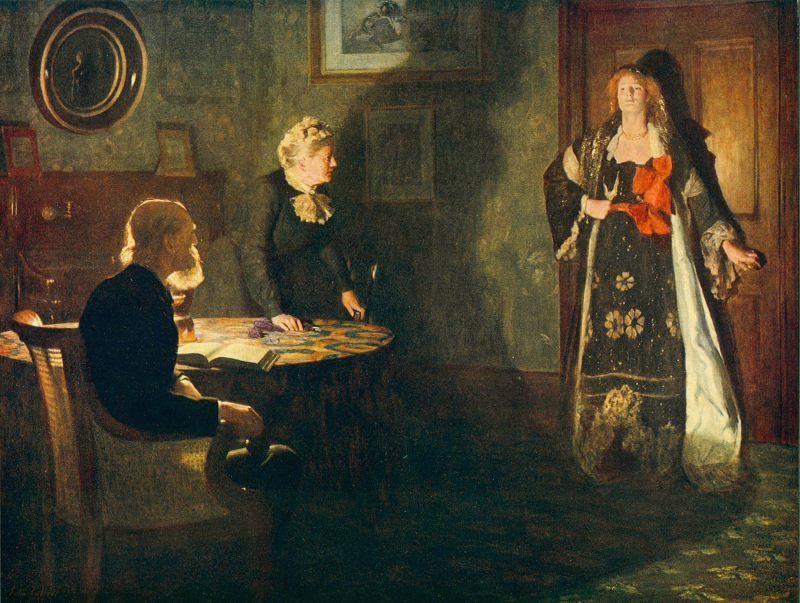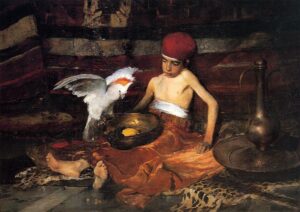Paintings of the fallen woman: 2 Salvation or decline?

During the nineteenth century paintings telling the story of the fallen woman had become popular, following an innovative moralising series painted early in the previous century by William Hogarth, and widely seen in prints. Young women were apparently lured from the country surrounding major cities such as London and Oslo, some to work as seamstresses initially, others directly into prostitution. In this second article, I look at what happened to them next.
Christian Krohg (1852–1925), Albertine in the Police Doctor’s Waiting Room (1885-87), oil on canvas, 211 x 326 cm, Nasjonalgalleriet, Oslo, Norway. Wikimedia Commons.
Just before Christmas 1886, Christian Krohg’s first novel Albertine was published by a left-wing publisher. Its central theme is prostitution in Norway at the time, and the police quickly seized all the copies they could find, banning it on the grounds of violating the good morals of the people. Krohg was found guilty of the offence the following March and fined, although the police were only able to seize 439 of the first 1600 copies to go into circulation.
At the same time as he was writing that novel, Krohg had been working on his largest and most complex painting: Albertine in the Police Doctor’s Waiting Room (1885-87). He also painted several other scenes from the book.
In the novel, Albertine starts as a poor seamstress, who is mistaken for a prostitute by the police officer in charge of the section controlling prostitutes. He plies her with alcohol, then rapes her. She is summoned to be inspected by the police doctor, whose examination further violates her, making her think that she is destined to be a prostitute, and that is, of course, exactly what happens.
Albertine is not the prominent woman in the centre looking directly at the viewer: Krohg’s heroine is the simple and humble country girl at the front of the queue to go into the police doctor for inspection.
Behind her is a motley line of women from a wide range of situations. At the right, in the corner of the room, is another country girl with flushed cheeks. Others are apparently more advanced in their careers, and stare at Albertine, whose profiled face is barely visible from behind her headscarf. Barring the way to the surgery door, and in control of the proceedings, is a policeman.
Joaquín Sorolla y Bastida (1863–1923), White Slave Trade (1895), oil on canvas, 166.5 x 194 cm, Museo Sorolla, Madrid, Spain. Wikimedia Commons.
During Joaquín Sorolla’s period of Naturalist painting, he depicted the contemporary trade in prostitutes in Spain. His White Slave Trade (1895) is set in a bleak railway compartment, where four young women are asleep while being transported in the care of a much older woman.
In contrast to their guardian, who wears black, the young women are dressed in bright-coloured Valencian regional costumes, and wear fashionable shoes. Their few possessions are stacked on the bench at the right, and include a guitar. The ‘slave trade’ to which Sorolla’s title refers is, of course, the movement of prostitutes between brothels. This could have been from Valencia to the port of Cartagena, then over to Orán and Algeria.
The fallen woman could have other origins, as depicted by Augustus Leopold Egg in his narrative series from 1858, Past and Present.
Augustus Leopold Egg (1816–1863), Past and Present, No. 1 (1858), oil on canvas, 63.5 x 76.2 cm, The Tate Gallery, London. Photographic Rights © Tate 2016, CC-BY-NC-ND 3.0 (Unported), http://www.tate.org.uk/art/artworks/egg-past-and-present-no-1-n03278
The first shows an ordinary middle-class drawing room, in which there are mother, father, and two young daughters, each well-dressed. Most striking is the mother, who is stretched out across the green carpet, prone. Her arms are stretched beyond her head, which is buried face down between her upper arms, and the hands are clasped together in tension.
The father is sat at a substantial circular table, facing the viewer. He is staring, brow furrowed, looking extremely tense and worried. His left hand holds a small note; his right hand is clenched, and rests on the table. His left shoe presses a miniature painting into the carpet.
The daughters are playing together at the left, opposite their father. One kneeling, the other sat, on the carpet, they are building a house of cards, which is just about to fall. One stares, her mouth slightly open in anxious surprise, looking towards where her mother might have been standing before she fell to the floor. The other girl is still looking intently at the house of cards.
As with Hogarth’s narrative series, the room is full of cues, clues, and symbols to the narrative. Among the more visible are: the collapsing house of cards; an apple has been cut in two, one half left on the table, the other on the carpet by the mother; the reflection of an open door indicating the imminent departure of the mother.
Egg also uses Hogarth’s technique of paintings within the painting. On the wall at the left is the expulsion of Adam and Eve titled The Fall, below which is a miniature portrait of the mother; at the right is a shipwreck by Clarkson Stanfield titled Abandoned, below which is a miniature portrait of the father.
Egg’s three paintings have no individual titles, but when exhibited were accompanied by the text:
August the 4th. Have just heard that B______ has been dead more than a fortnight, so his poor children have now lost both parents. I hear she was seen on Friday last near the Strand, evidently without a place to lay her head. What a fall hers has been!
The clear implicit narrative is that the mother was in an adulterous relationship, which was revealed to the father in this moment of peripeteia. The other two paintings show the consequences.
Augustus Leopold Egg (1816–1863), Past and Present, No. 2 (1858), oil on canvas, 63.5 x 76.2 cm, The Tate Gallery, London. Photographic Rights © Tate 2016, CC-BY-NC-ND 3.0 (Unported), http://www.tate.org.uk/art/artworks/egg-past-and-present-no-2-n03279
The two daughters are shown significantly older now. The senior is sat, staring vacantly out of the open window at a three-quarter full moon, while her younger sister buries her face between the older’s knees, kneeling partly in prayer, and partly in grief. On the wall, separated by the window, are the miniature portraits of their parents. The sparsely furnished room, with bare floorboards, indicates their fall into poverty.
Augustus Leopold Egg (1816–1863), Past and Present, No. 3 (1858), oil on canvas, 63.5 x 76.2 cm, The Tate Gallery, London. Photographic Rights © Tate 2016, CC-BY-NC-ND 3.0 (Unported), http://www.tate.org.uk/art/artworks/egg-past-and-present-no-3-n03280
Meanwhile the mother is homeless, sat among the debris under the arches of one of London’s bridges. She stares wide-eyed and fearful at a star in the sky, cradling a young baby to her, under her thin cloak. Behind her, on the side of the arch, are old posters, one with the word VICTIMS prominent, another advertising excursions to Paris.
John Collier (1850–1934), The Sinner (1904), oil on canvas, 147.3 x 108 cm, Victoria Art Gallery, England. The Athenaeum.
This story was also used by the master of the problem picture, John Collier, for example in The Sinner from 1904. This shows a woman, possibly dressed in widow’s weeds, making an emotionally charged confession.
William Holman Hunt (1827-1910), The Awakening Conscience (1851-53), oil on canvas, 76.2 x 55.9 cm, The Tate Gallery (Presented by Sir Colin and Lady Anderson through the Friends of the Tate Gallery 1976), London. © The Tate Gallery and Photographic Rights © Tate (2016), CC-BY-NC-ND 3.0 (Unported), https://www.tate.org.uk/art/artworks/hunt-the-awakening-conscience-t02075
One of the earliest major paintings lacking narrative closure is William Holman Hunt’s The Awakening Conscience, painted during the period 1851-53. The viewer of the day was expected to notice small clues such as the absence of a wedding band on the ring finger of the woman’s left hand, telling them theirs is an extra-marital relationship. Other clues are more symbolic: the cat under the table has caught a bird with a broken wing. The cat implies she is a ‘kept woman’ who needs its company, and the bird represents her moral plight.
The couple have been singing together when she appears to have undergone some revelatory experience, causing her to rise. For Hunt this is associated with a verse from the Old Testament book of Proverbs: “As he that taketh away a garment in cold weather, so is he that singeth songs to an heavy heart.” He leads us to imagine that this kept mistress has had a religious moment, seeing the route to her redemption as her conscience is awakened. The image brings hope without resolution.
John Collier (1850–1934), The Prodigal Daughter (1903), oil on canvas, 166 x 217 cm, Usher Gallery, Lincoln, England. WikiArt.
John Collier had attained fame with The Prodigal Daughter in 1903, which remains one of his best-known works.
An elderly middle-class couple are seen in their parlour in the evening in their sober black clothes and sombre surroundings. They’re surprised when their prodigal daughter turns up out of the blue, in her low-cut gown with floral motifs and scarlet accessories.
Father is still sitting, backlit by a table lamp to heighten the drama. Mother has risen from her chair and is visibly taken aback. Daughter stands, her back against the door and her hand still holding its handle, as if ready to run away again should the need arise. Collier also uses ingenious shadow play, a device which became popular in the nineteenth century perhaps with the advent of optical projectors: here the mother’s cast shadow makes her appear much larger than the daughter’s, like an ogre bearing down on a child.
This immediately sparked debate over the role of women in the modern world, the nature and scope of their family responsibilities, and changing class boundaries. Collier went to great lengths to capture the expressed emotions, in terms of the daughter’s facial expression, and their contrasting body language. The daughter is seen as a ‘fallen woman’, but far from appearing fallen and repentant, she stands tall, proud, and wears a rich dress. The resulting discussion spilled over from art gossip columns into more general editorial and comment sections of the press.
Antoni Piotrowski (1853–1924), Homeless (Country girl at the fence) (1896), oil on canvas, 110.5 × 150.5 cm, Muzeum Narodowe w Warszawie, Warsaw, Poland. Wikimedia Commons.
Neither was the fallen woman confined to England and Norway. Antoni Piotrowski’s Homeless (Country girl at the fence) (1896) shows a young pregnant Polish woman standing barefoot by the side of a country road. Her meagre possessions are laid out around her: a pair of worn boots, a bundle of clothes, and a stick.
Redemption was unusual, either in literary or visual accounts. The ultimate fate of the fallen woman was most usually into destitution.
John Everett Millais (1829–1896), Blow Blow Thou Winter Wind (1892), oil on canvas, 108 x 155 cm, Auckland Art Gallery Toi o Tāmaki, Auckland, New Zealand. Wikimedia Commons.
In 1892, John Everett Millais painted his bleak Blow Blow Thou Winter Wind. It’s a bitter day in the British winter, snow already on the ground and more snow on its way. An icy wind is blowing, and there is little shelter. In the foreground, a destitute mother sits, cradling her young baby inside an inadequate shawl, her few worldly possessions in a small bundle beside her. Behind a dog bays into the air, and a man walks into the distance.
Fernand Pelez (1848-1913), Homeless (1883), oil on canvas, 77.5 x 136 cm, location not known. Image by Bastenbas, via Wikimedia Commons.
The younger children shown in this family living on the street, in Fernand Pelez’ Homeless from 1883, have no footwear at all, and their feet are filthy; the mother and her older daughter are wearing tatty boots, perhaps to support them in casual work, when it’s available. This painting was exhibited at the Salon in Paris that year, when those viewing it only needed to walk round the corner from the Palais des Champs-Élysées (where it was held) to see scenes like this for real.




